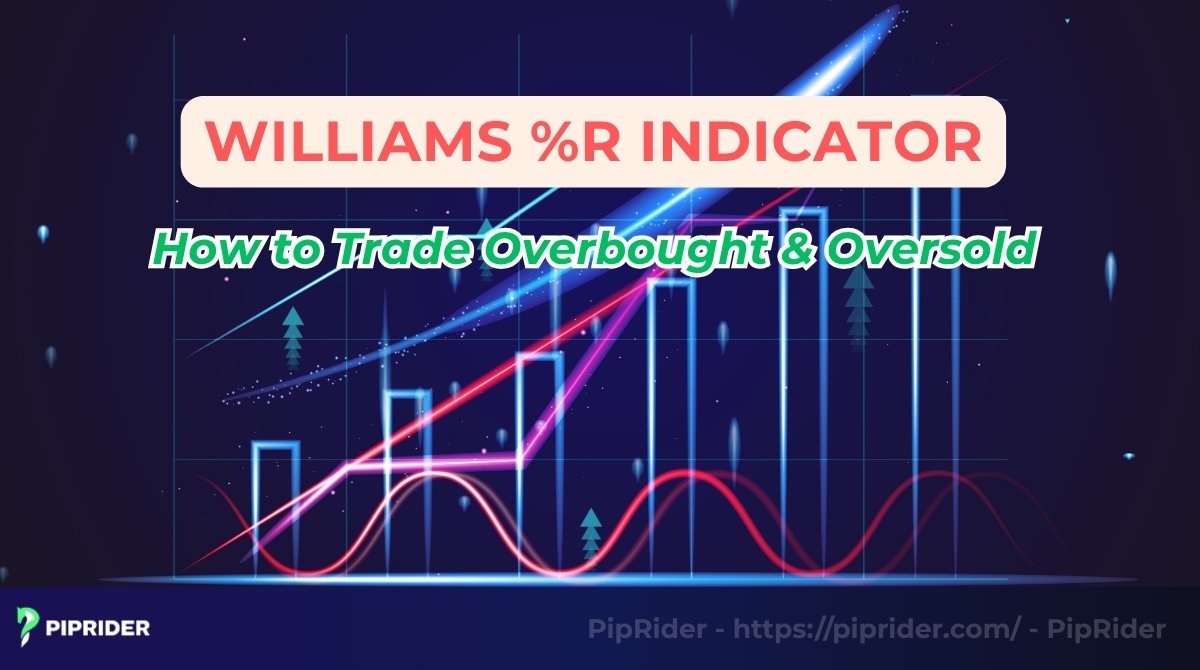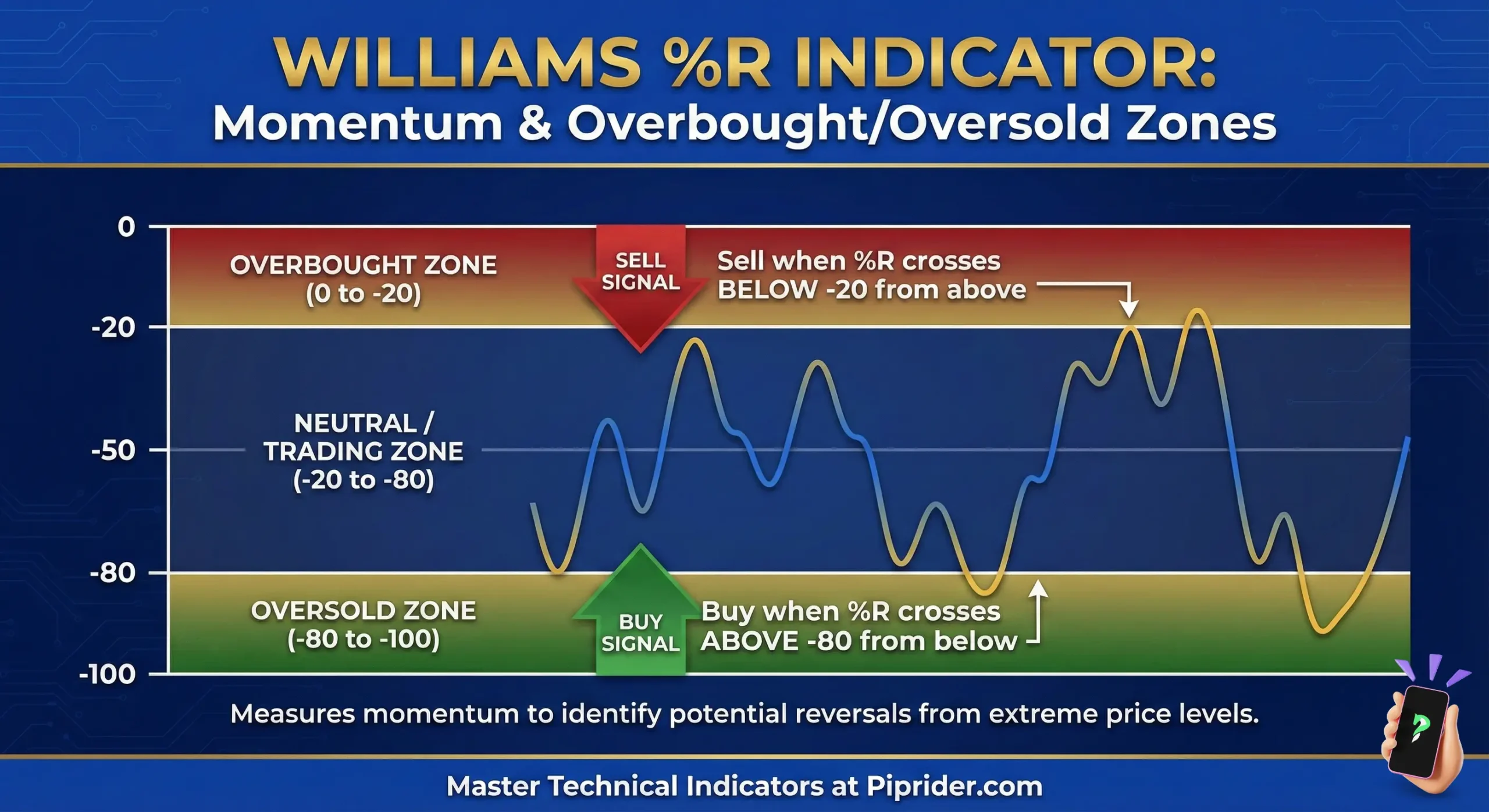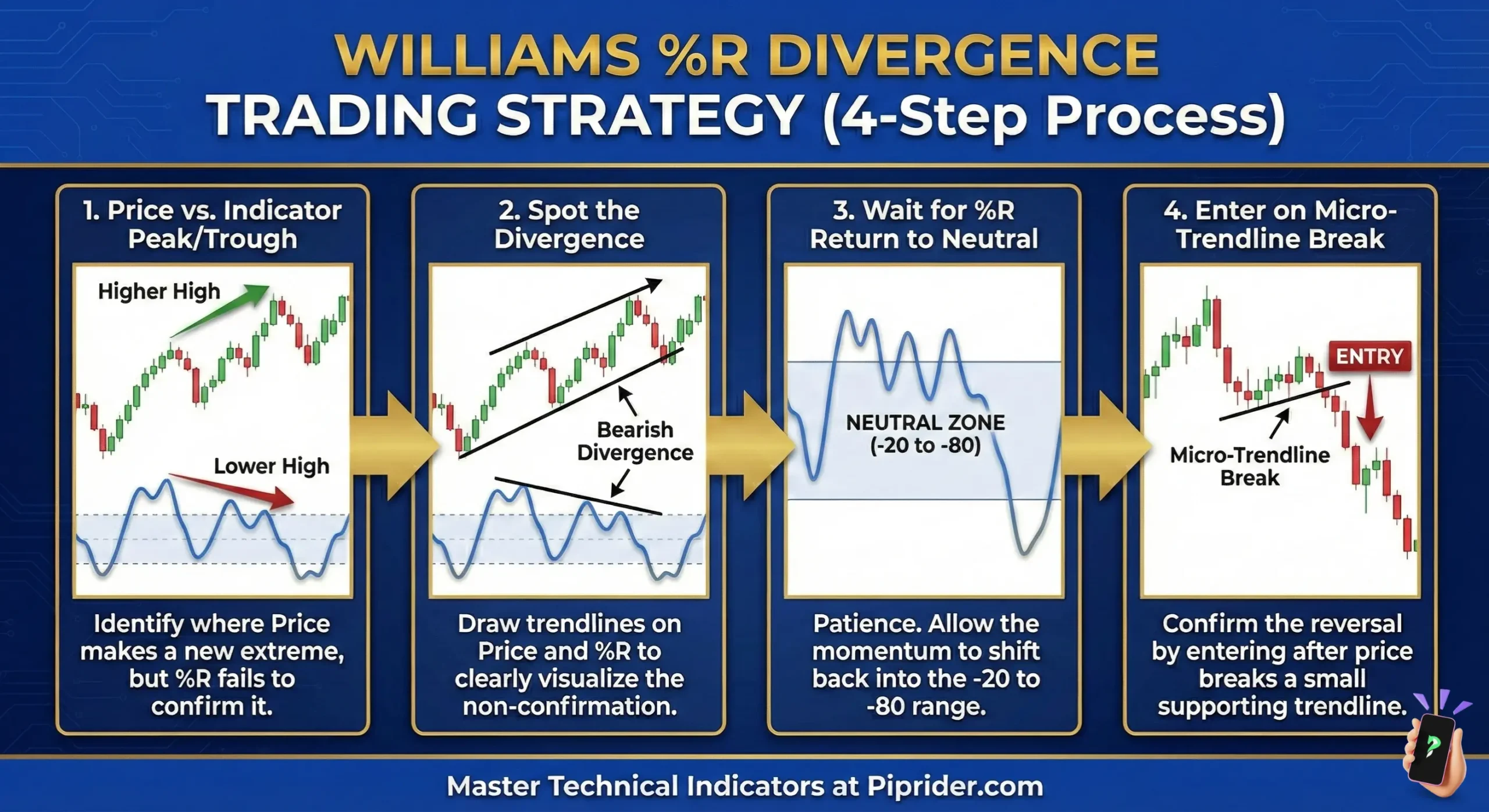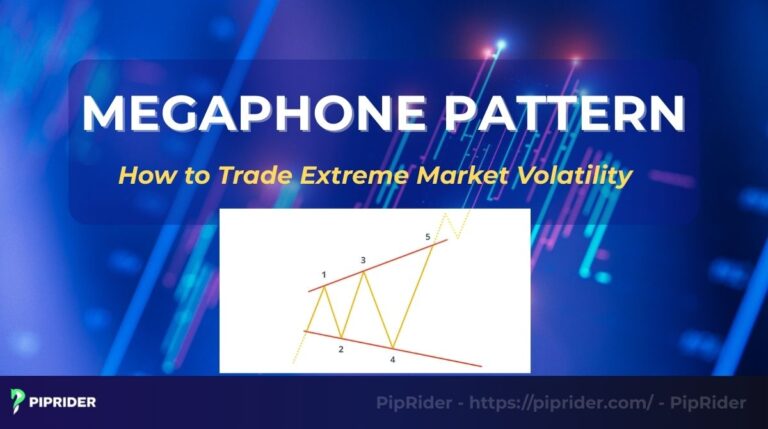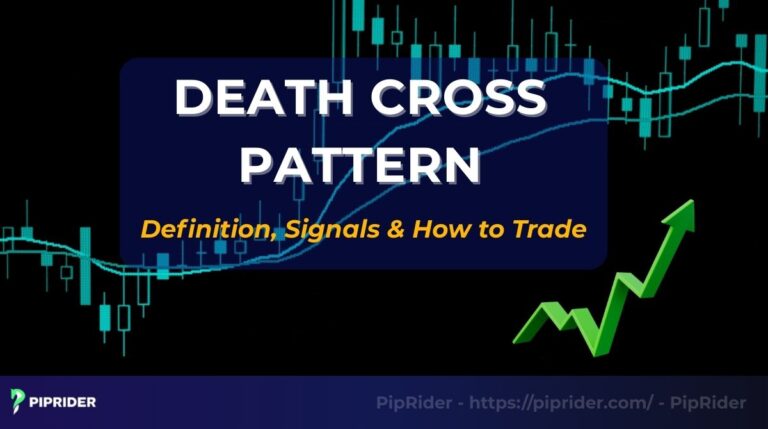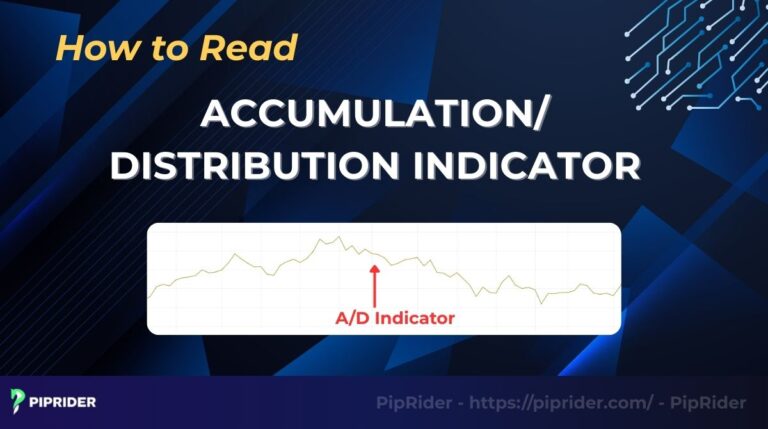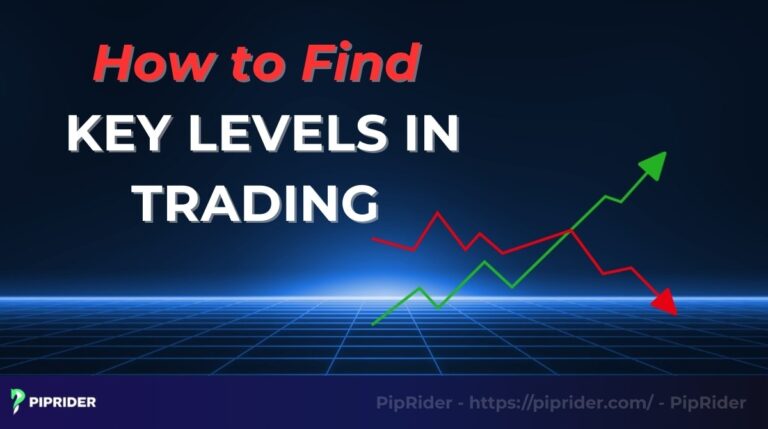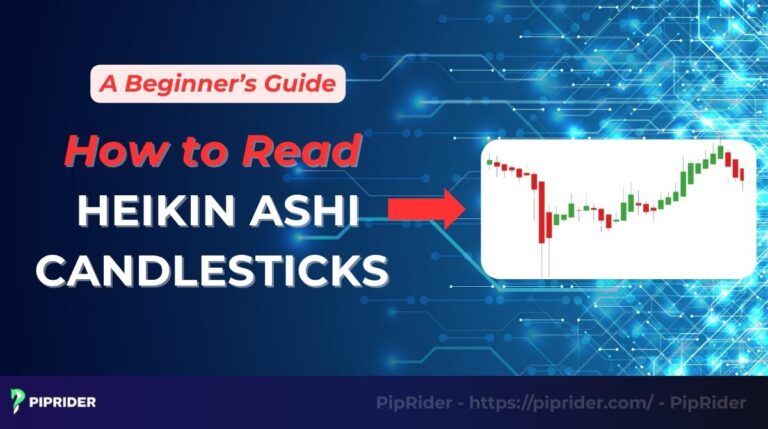Tired of chasing the market and constantly missing the big reversals? Imagine having a tool that instantly tells you when a stock, crypto, or currency is poised for a major price snapback. Enter the Williams %R indicator (Williams Percent Range). This simple but powerful momentum indicator is your early warning system for market fatigue. It cuts through the noise, signaling unsustainable extremes to perfectly time your entry and exit signals.
This guide reveals how to leverage the %R’s unique precision to trade overbought and oversold conditions like a true professional.
Key Takeaways
- Williams %R is a momentum oscillator developed to measure the speed at which price hits the high or low of a recent range.
- It’s the inverse of the Fast Stochastic Oscillator, oscillating between 0 and −100.
- Readings from 0 to −20 signal overbought conditions; −80 to −100 signal oversold conditions.
- The most reliable signal occurs when the indicator moves out of an extreme zone, confirming the reversal is underway.
- Williams R indicator is fast but noisy. It must be combined with trend analysis (e.g., Moving Averages) to filter false signals, especially during strong, sustained trends.
1. What Is the Williams %R Indicator?
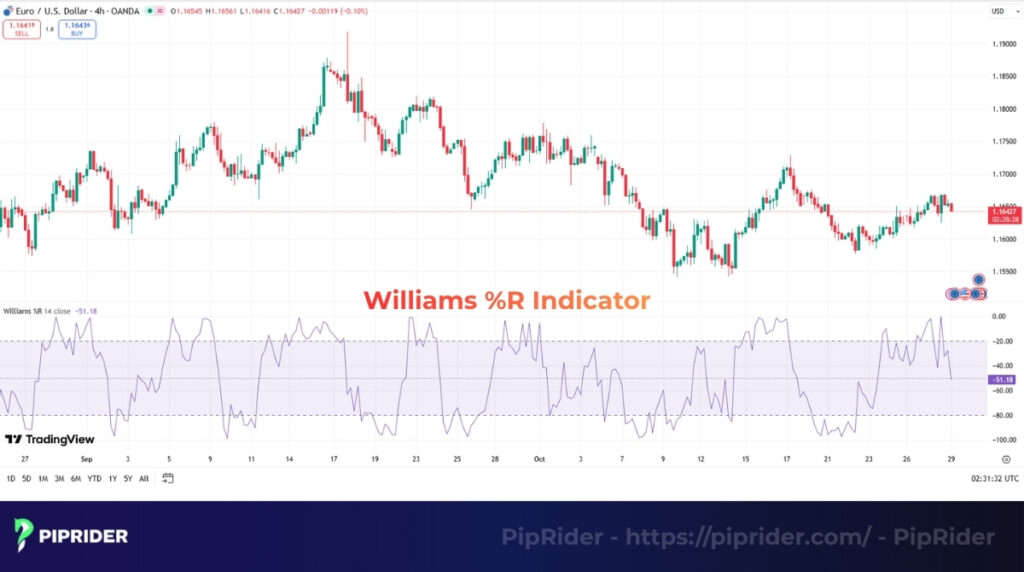
The Williams %R (Williams Percent Range) is a powerful momentum oscillator developed by legendary trader Larry Williams in the 1970s (StockCharts.com, 2024)
The indicator’s primary function is to measure buying and selling pressure. It is calculated by comparing the current closing price against the highest and lowest prices within a specified look-back period (typically 14 periods).
This measurement directly reflects how much momentum remains in a move: if the close is near the top of the range, momentum is strong; if it’s near the bottom, momentum is weak.
The Williams %R offers an inverted view compared to other popular oscillators. It differs from the RSI (magnitude of changes) and the Stochastic Oscillator (close relative to the low of the range). The %R focuses on the distance to the highest high and uses a unique scale that runs from 0 to −100. This makes it an extremely sensitive and fast tool for detecting potential short-term reversals.
Read more:
Chaikin Oscillator (CO): A forex trader’s guide to signals
Percentage Price Oscillator (PPO): Measuring Market Momentum
2. How the Williams %R Works
The Williams percentage range works on a simple yet powerful logic: it measures the current short-term strength of buyers and sellers by determining how close the closing price is to the extremes of its recent trading range.
The indicator is unique because it oscillates within an inverted range of 0 to −100.
- When the reading approaches 0 (e.g., −20 or higher), it means the closing price is near the highest high of the look-back period. This indicates strong buying pressure and an overbought market, suggesting a potential price reversal to the downside.
- When the reading approaches −100 (e.g., −80 or lower), the closing price is near the lowest low. This signals intense selling pressure and an oversold market, often preceding a potential upward reversal.
Traders specifically use the extreme readings of the Williams %R to detect early reversal points, anticipating a snapback when the buying or selling momentum has reached an unsustainable peak. This mechanism is rooted in the principle of mean reversion.
Read more:
Alligator Indicator: Best forex trading guide
Forex Trading 2025: Unleash DeMarker Indicator’s (DeM) Power
Fractal Trading: A Breakout Strategy Guide For Forex Traders
3. How to Calculate the Williams %R
The calculation of the Williams %R is essential to understanding its logic, as it directly translates the closing price’s position into a percentage reading relative to the chosen look-back period.
3.1. The Formula
The %R compares the distance from the highest high to the current close against the entire high-low range of the look-back period. The resulting value is then multiplied by −100 to create the unique, inverted scale.
%R = (Highest High − Current Close) / (Highest High − Lowest Low) × (−100)
- Highest High: The highest price recorded over the specified period (e.g., the last 14 days).
- Lowest Low: The lowest price recorded over the specified period.
- Current Close: The most recent closing price.
3.2. Step-by-Step Calculation Example
Let’s assume a standard 14-period look-back for an asset:
- Determine the Range: Find the highest high ($105) and the lowest low ($95) over the last 14 periods. The total range is
$105 − $95 = $10
- Determine the Close Position: If the current close is $104.
- Apply the Formula:
%R = ($105 − $104) / ($105 − $95) × (−100)
%R = ($1 / $10) × (−100) = 0.1 × (−100) = −10
- Interpretation: A reading of −10 means the close is only 10% down from the highest high of the last two weeks, confirming the market is heavily overbought. If the close were $96, the calculation would yield −90, confirming an oversold condition.
3.3. Recommended Settings
The look-back period (N) directly impacts the sensitivity and number of signals the indicator generates.
| Trading Style | Recommended Period (N) | Rationale |
| Scalping/Day Trading | 9 Periods | Less filtering for faster signals; highly sensitive to intraday moves. |
| Swing Trading (Default) | 14 Periods | The standard setting offers a balanced view of short-term momentum. |
| Position Trading | 21 Periods | Smoother, less volatile signals; ideal for catching major turns in longer trends. |
4. How to Interpret Williams %R Indicator
Interpreting the %R involves monitoring the indicator’s position within its −100 to 0 range to gauge market extremes and underlying momentum shifts. This process is fundamental to effective technical analysis.
4.1. Overbought and Oversold Levels
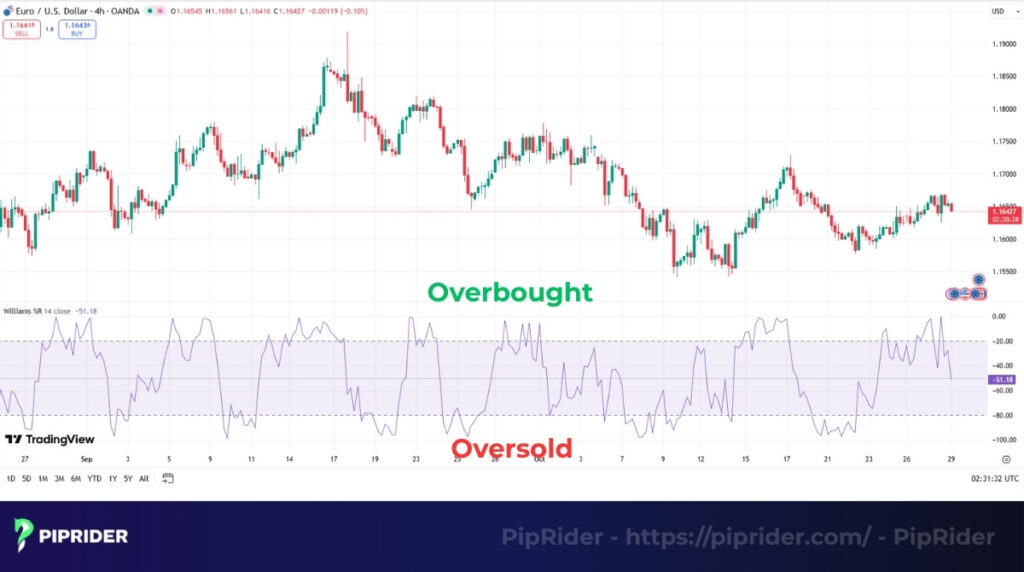
These extreme zones are the core function of the Williams %R.
- Overbought (OB): 0 to −20
- Meaning: The closing price is near the highest high of the period.
- Signal: Suggests excessive buying, increasing the risk of a downside reversal.
- Oversold (OS): −80 to −100
- Meaning: The closing price is near the lowest low of the period.
- Signal: Suggests excessive selling, increasing the risk of an upside reversal.
4.2. Momentum Failure Signals
Failure signals occur when a strong price trend is not confirmed by the indicator’s ability to reach its extreme zone during a pullback.
- Bullish Failure: Price pulls back, but %R fails to drop below −80. This indicates weak selling pressure and reinforces the uptrend.
- Bearish Failure: Price rallies, but %R fails to rise above −20. This signals weak buying pressure and reinforces the downtrend.
4.3. Divergences
Divergence is a crucial advanced signal that anticipates a potential trend change.
- Bullish Divergence: Price makes a lower low, but %R makes a higher low. This suggests selling momentum is secretly weakening, giving an early signal for an upward reversal.
- Bearish Divergence: Price makes a higher high, but %R makes a lower high. This signals buying pressure is fading, anticipating a potential move down.
4.4. Center Zone Movement
The −50 centerline is the critical balance point between buyer and seller control.
- Above −50: Prices are trading in the upper half of the recent range. Buyers have the advantage (momentum is positive).
- Below −50: Prices are trading in the lower half of the recent range. Sellers have the advantage (momentum is negative).
Crossing the −50 line indicates a shift in short-term directional control.
5. How to Trade Using Williams %R
Williams %R is rarely used in isolation; its power lies in confirming or timing entries within an established market context. These strategies combine the indicator’s core signals with price action and trend analysis. The ability to generate clear trading signals makes it invaluable.
5.1. Strategy 1 – Reversal Trading (Fading the Extreme)
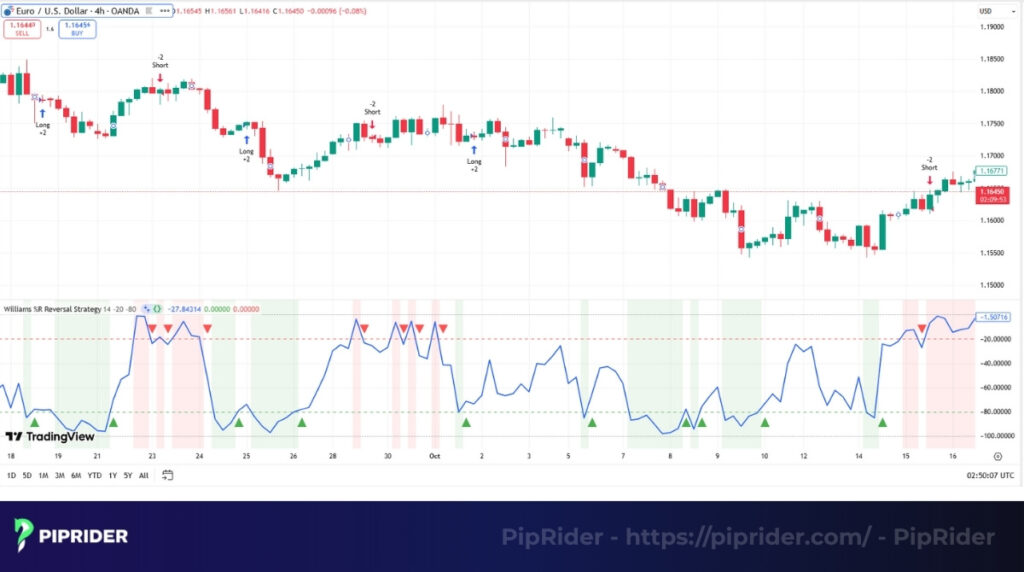
This is the most common use of the indicator: capitalizing on the snapback from overextended market conditions.
- Buy Signal (Long Entry): Wait for the %R to cross back up above the −80 line after being deep in the oversold zone (−80 to −100). This signals that selling pressure has peaked and momentum is shifting back to the upside.
- Sell Signal (Short Entry): Wait for the %R to cross back down below the −20 line after being deep in the overbought zone (0 to −20). This suggests buying pressure has been exhausted and momentum is shifting back to the downside.
This strategy is highly effective in range-bound (sideways) markets.
5.2. Strategy 2 – Trend Confirmation (Trading the Pullback)
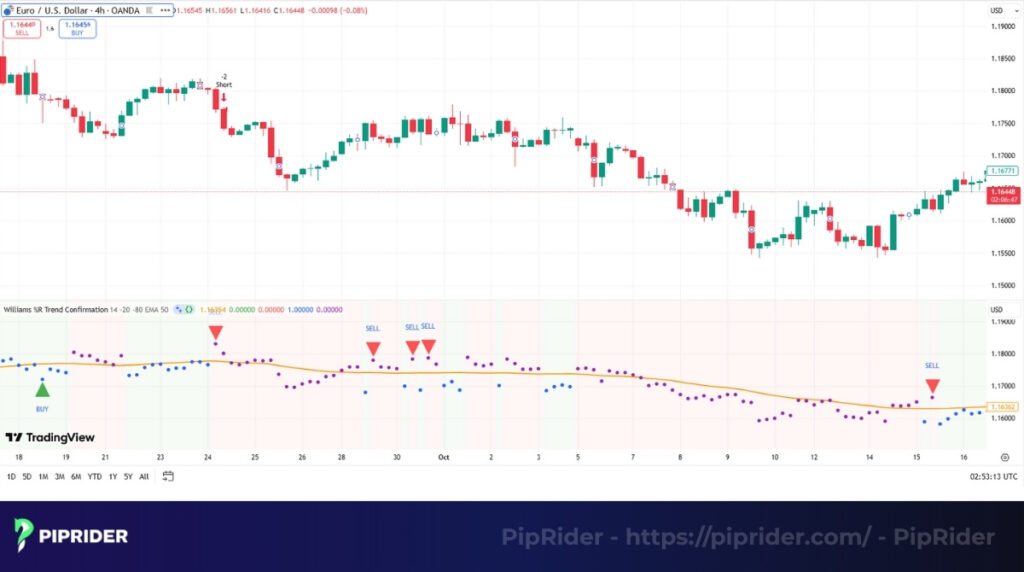
Since the Larry Williams indicator is fast and noisy, pairing it with a Moving Average (MA) is crucial for filtering signals and trading pullbacks within a defined trend. This is essential for proper trend identification.
- Bullish Trend (Price > MA): Only take buy signals (R crossing up from −80). Ignore all sell signals that occur while the price remains above the key MA (e.g., 50-period EMA). The oversold reading on %R simply confirms a healthy pullback within the larger uptrend.
- Bearish Trend (Price < MA): Only take sell signals (R crossing down from −20). Ignore all buy signals. The overbought reading confirms a relief rally within the larger downtrend.
5.3. Strategy 3 – Breakout Filtering
Williams %R indicator can help confirm the legitimacy of a price breakout by measuring the momentum accompanying the move.
- Confirmed breakout: When price breaks a key technical level (support or resistance), the breakout is considered stronger if the %R moves aggressively away from the −50 center zone towards the new extreme (−20 or −80). This confirmation is ideally supported by increasing volume.
- False breakout (Fade): If the price breaks out but the %R remains stagnant around the −50 line or quickly reverses course, it suggests a lack of underlying momentum and increased risk of a failed breakout.
Read more:
3 Commodity Channel Index CCI Trading Strategy for Forex Traders
6. Overbought/Oversold in Real Market Context
Interpreting the extreme zones of the Williams %R requires understanding how they behave during strong trends, which is the source of most false signals. This deeper understanding is part of a comprehensive market analysis.
In a real market context, an extreme reading often signals trend strength, not immediate reversal.
- During a strong uptrend: The %R can remain overbought (0 to −20) for long periods. This simply means the price is consistently closing near its highest high, confirming sustained buying pressure. It is not a signal to short.
- During a strong downtrend: The %R can remain oversold (−80 to −100). This confirms sustained selling pressure, as the price keeps closing near its lowest low. It is not a signal to buy.
To avoid trading prematurely against a powerful trend, traders must seek confirmation before acting on an extreme reading:
- Exit confirmation: Wait for the %R to move out of the extreme zone and, ideally, cross the −50 centerline. A sustained move below −50 (after Overbought) confirms a strong downward shift.
- Trend confirmation: The most reliable filter is a trend-following tool (e.g., a 50-period Moving Average). Only validate buy signals from %R if the price is above the MA, and only validate sell signals if the price is below the MA.
7. Using Williams %R with Other Indicators
The Williams %R is a fast, reactive tool, but its high sensitivity requires confirmation. Pairing it with other indicators helps filter whipsaws and validates the trade context.

- %R + RSI (Double Confirmation): Pairing the fast %R with the smoother Relative Strength Index (RSI) provides double confirmation of overbought/oversold extremes. Agreement between both oscillators significantly increases trade conviction.
- %R + MACD (Trend Validation): Use the Moving Average Convergence Divergence (MACD) to establish the prevailing market bias. Only validate buy signals from %R when the MACD is bullish and sell signals when the MACD is bearish, filtering signals that contradict the main trend.
- %R + Bollinger Bands (Breakout Filter): %R helps validate if a move hitting the Bollinger Bands is a legitimate breakout (confirmed by %R moving aggressively into an extreme zone) or just a short-term fade.
- %R + Volume/OBV (Reversal Strength): A reversal signal from %R is stronger when supported by money flow. Look for a simultaneous increase in volume or an uptick in the On-Balance Volume (OBV) to confirm that major market players are backing the momentum shift.
8. Williams %R vs. RSI – Which Is Better?
The Williams %R, the Relative Strength Index (RSI), and the True Strength Index TSI are all momentum oscillators, but they use different calculations and excel in different market environments. Deciding which is “better” depends entirely on your trading objective and the current market condition.
| Criteria | Williams %R | Relative Strength Index (RSI) |
| Range | Inverted: 0 to −100 | Standard: 0 to 100 |
| Calculation Focus | Compares close to the highest high (measures speed/range position). | Compares magnitude of recent gains to losses (measures momentum magnitude). |
| Signal Speed | Faster and more sensitive (reactive). | Smoother and less volatile (better filtering). |
| Ideal Use | Short-term reversals and timing entries for quick snapbacks. | Momentum trend analysis and validating long-term strength/weakness. |
| Best Market | Range-bound or highly volatile markets. | Trending markets (uptrends/downtrends). |
Analysis: When to Use Which?
The key distinction lies in their calculation and resulting speed:
- Use %R when: You are a scalper or short-term swing trader focused on catching rapid, short-lived movements or price reversals at the extremes of a defined range. Its speed makes it a superior timing indicator.
- Use RSI when: You are a swing trader or position trader focused on trend continuation and need a smoother indicator to avoid whipsaws. RSI excels at measuring the sustained magnitude of momentum, making it better for trend validation.
In short: Williams %R is better for timing extremes, while RSI is better for validating the strength of a trend.
9. Momentum Failure and Backtesting
Understanding momentum failure is crucial for differentiating a true reversal from a temporary pause in a strong trend. Quantifying a trading strategy using backtesting is essential to validate its edge and improve risk-adjusted return.
Momentum failure occurs when a strong price trend attempts to continue, but the Williams %R fails to reach the extreme zone it previously touched, signaling exhaustion.
| Failure Type | Signal & Interpretation |
| Bullish Failure | Price pulls back, but %R fails to drop below −80. Interpretation: Selling pressure is weak; the uptrend is likely to resume. |
| Bearish Failure | Price rallies, but %R fails to rise above −20. Interpretation: Buying pressure is weak; the downtrend is likely to continue. |
This failure to break the prior extreme provides an early warning that the dominant trend is weakening, often preceding a sharp move in the opposite direction.
Backtesting is necessary to ensure a Williams R indicator strategy offers a reliable, statistical advantage on a specific asset or timeframe.
| Criterion | Suggested Setup (Example) |
| Entry Rule (Buy) | %R crosses up above −80, and the price is above the 50-period EMA. |
| Exit Rule (Take Profit) | %R hits −20 (overbought) or the price crosses below a fast Moving Average (e.g., 10 EMA). |
| Risk Management | Stop-loss set at the lowest low recorded during the oversold period. |
The goal is to verify key metrics like win rate, profit factor, and max drawdown to validate the strategy’s profitability.
10. Example Scans and Code Implementation
Translating the Williams %R strategy into actionable code for scanners and trading platforms is essential for systematic trading. Below are the most simplified examples for buy and sell setups.
These signals focus on the core reversal trading strategy: exiting the extreme zones.
| Signal | Logic (Interpretation) | Meaning |
| Buy Setup | Williams %R (14) crosses UP above −80 (exiting oversold). | Confirms selling pressure has been exhausted, and momentum is shifting back up. |
| Sell Setup | Williams %R (14) crosses DOWN below −20 (exiting overbought). | Confirms buying pressure is depleted, and momentum is shifting back down. |
Coding Example (TradingView Pine Script)
Most platforms (TradingView, MetaTrader, Amibroker) use a built-in function to calculate the Williams %R.
| Setup | Code Condition (Logic) |
| Buy Signal | crosses(ta.williamsR(14), -80) |
| Sell Signal | crosses(-20, ta.williamsR(14)) |
Application: These formulas can be directly used in a platform’s scanner or alert system to automatically filter and identify assets. This feature provides high-probability reversal trade setups by highlighting assets moving out of an extreme zone.
11. Best Market Conditions for Williams %R
The Williams %R is a timing tool best utilized in specific market environments where its sensitivity is an advantage.
- Optimal conditions: Williams %R is most effective in range-bound (sideways) markets and for identifying short-term pullbacks within a trend. In these environments, the indicator consistently cycles between −20 and −80, generating reliable reversal signals when the price is due for a snapback.
- Suboptimal conditions: The indicator’s effectiveness decreases sharply during strong, sustained trends. Since the price keeps closing near its high or low, the %R will remain stuck in the 0 to −20 or −80 to −100 zones. This common occurrence leads to frequent false reversal signals (whipsaws).
- Optimized settings by asset: Adjusting the look-back period (N) maximizes performance based on an asset’s typical price fluctuations:
| Asset Class | Recommended Period (N) | Rationale |
| Forex / Crypto | 9 to 12 Periods | Shorter period for higher sensitivity to the fast, sharp reversals common in these volatile markets. |
| Stocks (Swing Trading) | 14 Periods | Standard setting for balanced signal reliability on daily charts. |
| Long-Term/Position | 21 to 28 Periods | Longer period filters minor noise, focusing on significant momentum shifts. |
12. Advantages and Limitations
The Williams %R is a popular and effective momentum tool due to its speed, but its inherent sensitivity creates certain drawbacks that traders must manage.
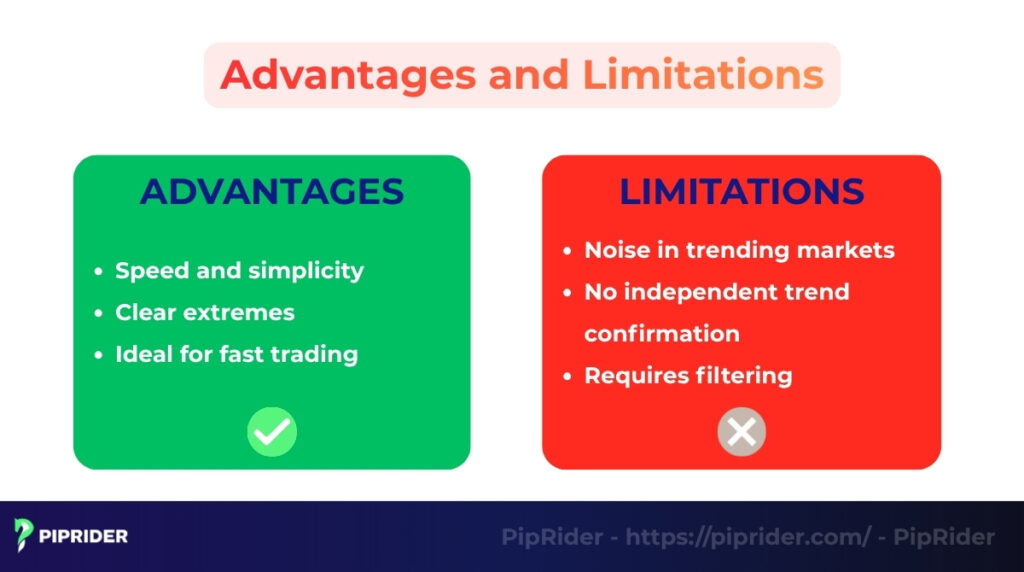
12.1. Advantages
The Williams %R offers significant benefits, particularly for short-term trading.
- Speed and simplicity: It is highly sensitive and quick to generate signals, making it an excellent timing indicator. The core concept, measuring the close against the recent price range, is straightforward.
- Clear extremes: The scale clearly defines overbought (0 to −20) and oversold (−80 to −100) levels, allowing traders to easily spot potential short-term reversal points.
- Ideal for fast trading: Its responsiveness makes it a favorite tool for scalpers and swing traders looking to capitalize on quick price snapbacks.
12.2. Limitations
The high sensitivity of Williams %R is also the source of its main drawbacks.
- Noise in trending markets: Its primary weakness is producing false reversal signals (whipsaws) during strong, sustained trends. The %R often sticks in an extreme zone, incorrectly suggesting a reversal.
- No independent trend confirmation: As a momentum oscillator, the Williams %R cannot independently confirm the long-term trend direction or strength; it only measures range position.
- Requires filtering: Due to its high noise, it must be combined with other technical tools (like Moving Averages or MACD) to filter out unreliable signals and provide necessary market context.
13. Frequently asked questions about Williams %R Indicator
14. Conclusion
The Williams %R is an essential tool for identifying short-term momentum and timing potential reversals. Its key function is the rapid identification of price extremes, signaling that momentum is likely exhausted. However, its high sensitivity is a flaw; the %R must never be used in isolation.
Always treat the Williams %R as a confirmation indicator. To maximize accuracy, pair it with a Moving Average (MA) as a trend filter to ensure signals align with the dominant market direction. Combine it with the RSI for momentum confirmation, which provides a higher-conviction signal on market extremes.
For more advanced trading strategies and broker insights, be sure to follow Piprider and explore our dedicated Broker Reviews section.


